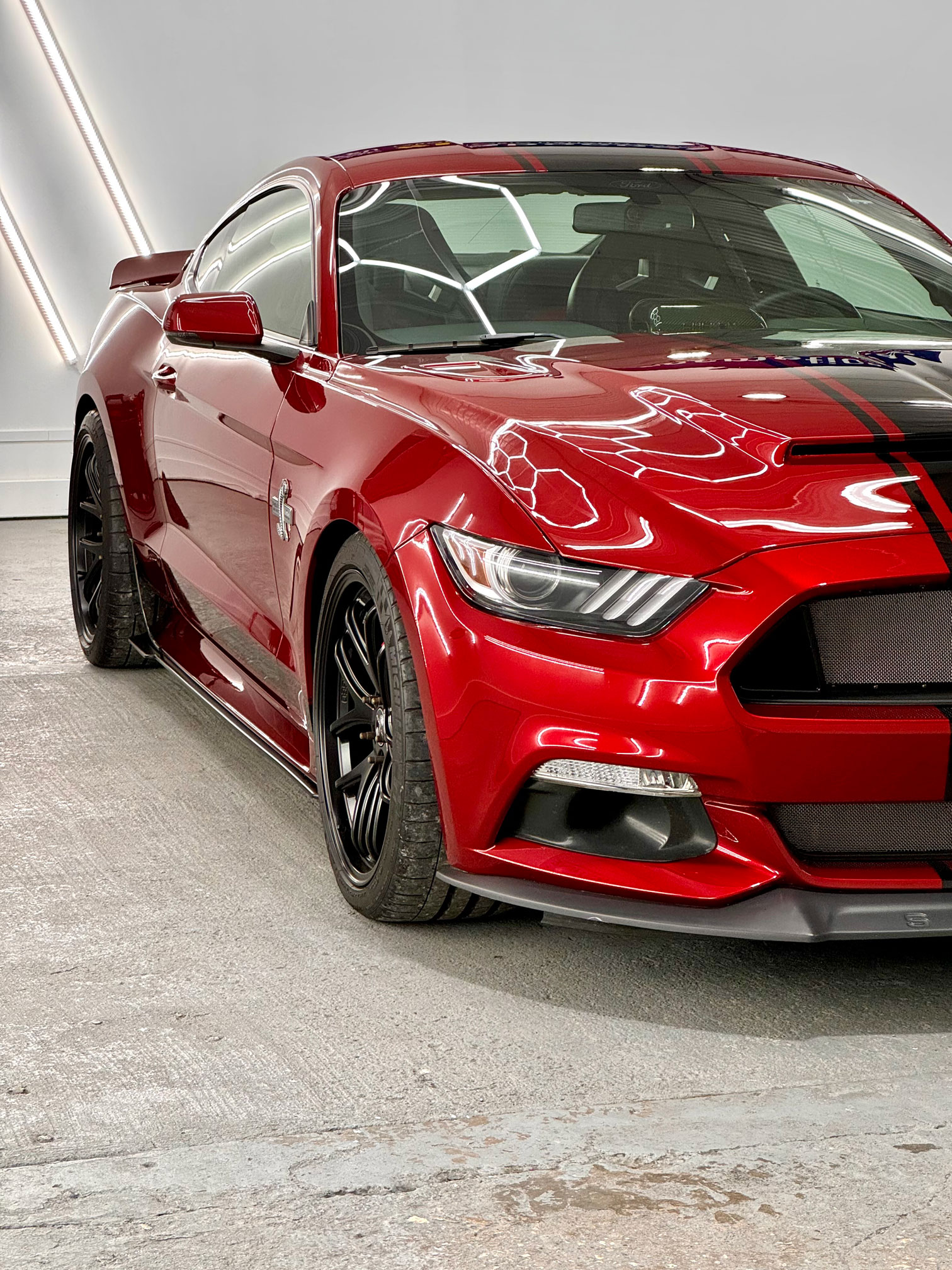Buying a new car is exciting! the paint shines, the finish is flawless, and you want to keep it that way for as long as possible. But the truth is, daily driving, weather, and time all take a toll on paint. That’s why so many people ask:
👉 “Should I ceramic coat my new car?”
It’s one of the most common questions we hear in auto detailing, and for good reason. Ceramic coating sounds almost too good to be true. Some people say it makes your car scratch-proof and maintenance-free, while others say it’s a waste of money.
The truth lies somewhere in the middle. In this guide, we’ll break down everything you need to know about ceramic coating for new cars, the pros, the cons, the cost, the comparisons, and the care.
Our goal is simple: to help you decide if ceramic coating is the right choice for you.
What Is a Ceramic Coating?
A ceramic coating is a liquid polymer applied to your car’s paint. Once cured, it chemically bonds with the clear coat, creating a durable layer of protection. Unlike wax or sealants, which sit on top of the paint and wear away quickly, a ceramic coating can last for years.
Benefits include:
-
Repelling water and dirt (hydrophobic effect)
-
Making cleaning easier
-
Protecting against UV rays and chemicals
-
Adding gloss and depth to the paint
But here’s the key: it’s not bulletproof. A ceramic coating will not stop rock chips, deep scratches, or dents. Think of it as long-term armor for your car’s finish, not an invisible force field.
Pros of Ceramic Coating for New Cars
✅ 1. Long-Lasting Protection
Unlike wax, which needs to be reapplied every few months, ceramic coatings can last 2–5 years or more depending on the product and how the car is maintained. This means you get protection season after season.
✅ 2. Easier Cleaning
A coated car is much easier to wash. Mud, dirt, and road grime don’t stick as much, and water beads up and rolls off the surface. You’ll spend less time scrubbing, and your car stays cleaner between washes.
✅ 3. Enhanced Gloss & Shine
Ceramic coatings create a “wet look” that enhances your new car’s paint. The depth and gloss go beyond what wax can achieve, and they don’t fade after a few weeks.
✅ 4. UV Protection
Sunlight and UV rays are some of the biggest threats to paint. Over time, they cause oxidation and fading. A ceramic coating helps block UV damage, preserving your car’s new-car look.
✅ 5. Stronger Chemical Resistance
Bird droppings, bug guts, road salt, and tree sap are acidic and can etch into paint. A ceramic coating gives you more time to safely remove them before damage happens.
Cons of Ceramic Coating for New Cars
❌ 1. Not Scratch- or Rock Chip-Proof
Ceramic coatings resist light swirls and marring, but they won’t stop deeper scratches or rock chips from gravel. If your main concern is impact damage, paint protection film (PPF) may be a better choice.
❌ 2. Higher Upfront Cost
Professional ceramic coatings typically range from $800 to $2,000+, depending on the vehicle size, coating brand, and how much paint correction is required. For some, this investment feels high compared to wax or DIY options.
❌ 3. Requires Proper Prep
Even new cars often arrive with swirl marks or defects from transport and dealership prep. To get the best results, a detailer must polish or perform paint correction and correct the paint before applying the coating. This adds cost but ensures the coating bonds properly.
❌ 4. Still Requires Maintenance
Ceramic coating does not mean “no maintenance.” You still need to:
-
Wash by hand regularly
-
Use pH-neutral car soap
-
Avoid harsh chemicals
🚫 Drive-thru car washes should be avoided when possible.
-
Brush washes will scratch and damage both the coating and paint.
-
Touch-free washes rely on strong chemicals that shorten coating life.
✅ The best method is hand washing with the proper products.
❌ 5. Not Permanent
Ceramic coatings are durable but not forever. Over time, they wear down and may need to be reapplied. Think of them as a long-term investment, not a lifetime guarantee.
Ceramic Coating vs. Wax vs. Sealant vs. PPF
| Protection Type | Lifespan | Gloss / Depth | Scratch / Impact Resistance | Typical Cost Range | Best For |
|---|---|---|---|---|---|
| Wax | ~2–3 months | Good shine | None | $20–$100 | Budget-friendly, short-term shine |
| Paint Sealant | ~6–12 months | Good | None | $50–$200 | DIY protection with longer durability than wax |
| Ceramic Coating Popular | ~2–5+ years (with care) | Excellent “wet look” | Light swirl resistance (not rock-chip proof) | $800–$2,000+ | Daily drivers wanting long-term shine & easier washing |
| Paint Protection Film (PPF) | ~5–10 years | Very good (or matte options) | High; absorbs rock chips & minor scratches | $1,500–$6,000+ | Maximum impact protection (front end or full car) |
*Lifespan and cost vary by vehicle size, prep level, product, and installer. Ceramic coatings still require proper hand washing; avoid drive-thru brush washes and use touch-free sparingly.
Is Ceramic Coating Worth It for a New Car?
Here’s the honest answer: it depends on your goals.
If you want the best protection for your new car’s paint and you plan to keep the car for years, ceramic coating is a smart investment. It will help your car look new longer, make cleaning easier, and protect against common threats like UV rays, salt, and bird droppings.
If you just want your car to shine for a few months or you don’t mind reapplying wax regularly, then ceramic coating may not be necessary.
Think of ceramic coating as insurance for your paint. It’s not required, but it adds peace of mind and long-term value.
How Much Does Ceramic Coating Cost for a New Car?
One of the most common questions is price. The cost of ceramic coating varies based on:
Vehicle size (sedan vs SUV vs truck)
Paint condition (new cars often still need correction)
Coating brand and warranty level
Detailer’s skill and reputation
Typical cost range:
Small cars: $800–$1,200
SUVs/trucks: $1,200–$2,000+
Add-on services (interior coating, wheels, glass) may raise the price
👉 Remember: a cheaper job often means corners were cut in prep or product quality.
How to Maintain a Ceramic Coating
To get the most from your coating:
Wash every 1–2 weeks with pH-neutral soap
Dry with microfiber towels to avoid water spots
Avoid drive-thru washes (both brush and touch-free)
Use ceramic boosters every few months to refresh hydrophobic properties
Annual inspections if you have a pro-grade or warranty-backed coating
👉 Proper care can make a ceramic coating last far beyond its rated lifespan.
Who Should (and Shouldn’t) Get Ceramic Coating?
Ceramic Coating Is Best For:
Car owners planning to keep their vehicle long-term
Enthusiasts who want their car to always look its best
People who wash their car by hand or are willing to learn proper care
Daily drivers exposed to sun, road salt, or tough conditions
Ceramic Coating May Not Be Worth It If:
You’re leasing a vehicle short-term
You don’t care much about long-term appearance
You plan to sell the car within 1–2 years
You rely heavily on drive-thru car washes
FAQ: Ceramic Coating for New Cars
Can you ceramic coat a brand-new car?
Yes! in fact, it’s the best time. But even new cars usually need light polishing before coating to remove minor defects.
Does ceramic coating replace waxing?
Yes. Once applied, you won’t need to wax your car anymore.
How long does ceramic coating last?
Professional coatings usually last 2–5 years. Some premium options can last 7+ years with proper care.
Does ceramic coating prevent scratches and rock chips?
No. It protects against light swirls, but it will not stop rock chips or deep scratches. For that, pair ceramic coating with PPF.
How soon after buying a new car should you ceramic coat it?
The sooner, the better. Ideally within the first few weeks of ownership before environmental damage sets in.
Does ceramic coating increase resale value?
Yes. A car with protected, well-maintained paint is more appealing to buyers and often commands a higher resale price.

